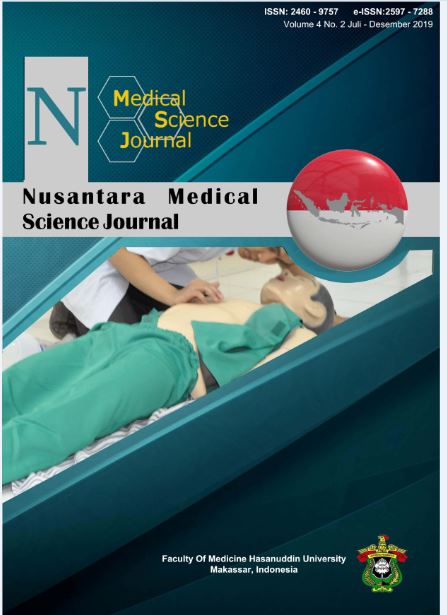Profile And Treatment of Stevens-Johnson Syndrome Patients in DR. Soetomo General Hospital
DOI:
https://doi.org/10.20956/nmsj.v4i2.5696Keywords:
Steven Johnson Syndrome, Drugs, CorticosteroidAbstract
Background: Stevens-Johnson Syndrome (SJS) is a rare but potentially life- threatening form of Severe Cutaneous Adverse Reaction (SCAR). SJS is mostly caused by drugs and is associated with high morbidity and mortality. Moreover, no standard treatment has been established for SJS. The aim of this study is to present epidemiological features, etiologies, clinical outcomes, medical histories, and treatments of SJS patients at the Inpatient Units Kemuning I and II Dr. Soetomo General Hospital between 2011 until 2015.
Methods: This retrospective study used secondary data collected from medical records. All patients in the Inpatient Units Kemuning I and II of Dr. Soetomo General Hospital from the year 2011 until 2015 who was diagnosed SJS were included in this study.
Result: There were 29 medical records consisting of 23 females and 6 males with the diagnosis of SJS found in 2011-2015. Most patients were aged 25-44 years old, with no family history of SJS. A majority first presented with a clinical history of fever. The main cause of SJS in this cohort was amoxicillin. Mucosal areas that were involved the most was the eye and mouth. Systemic treatments for patients were corticosteroid. The average duration of treatment was 15,88 days. None of the patients died.
Conclusion: SJS was more common in females compared to males. The main systemic therapy in Inpatient Units Kemuning I dan II of Dr. Soetomo General Hospital was intravenous cortiosteroid and no patients died.
References
Allanore,L.Valeyrie, Roujeau,Jean-Claude, 2012,’ Epidermal Necrolysis (Stevens-Johnson Syndrome and Toxic Epidermal Necrolysis)’, 8¬¬¬¬th ed, Fitzpatrick’s Dermatology in General Medicine, The Mc Graw-Hill Companies, pp 439-448.
Clinical Practice Guidelines SMF Dermato-Venerology RSUD Dr.Soetomo Surabaya 2014
Dalli, Rachel L, Kumar, Rohit,Kennedy Peter, Maitz, Peter, Lee, Stephen,Johnson, Rae, 2007,Toxic Epidermal Necrolysis/Steven Johnson Syndrome: Current Trends In Management’, Royal Australasian College of Surgeon, vol 77, pp 671-676
Harr, Thomas, French, Lars.E, 2010, ‘Steven Johnson Syndrome and Toxic Epidermal Necrolysis’ , Chem Immunol Allergy, ,vol. 97, hh.149-166.
Harsono, Ariyanto, 2006, “Sindroma Steven Johnson: Diagnosis dan Penatalaksanaan”, Fakultas Kedokteran Uniersitas Airlangga
Ho, HHF, 2008, “Diagnosis and Management of Steven-Johnson Syndrome and Toxic Epidermal Necrolysis”, The Hongkong Medical Diary, vol.13, no.10,hh 17-20
Kim JW, Kim ST, Song DH., 2004, ‘A clinical observation of the patients with
steven johnson syndrome and toxic epidermal necrolysis in Jeju Island’, Korea J Dermatology, vo’ 42, pp 579-591
Latif,Abdul, 2013, Analisis Bahan Kimia Obat Dalam Jamu Pegal Linu Yang Di Jual Di Surakarta Menggunakan Metode Spektrofotometri UV, Skripsi, Surakarta, Fakultas Farmasi Universitas Muhammadiyah Surakarta.
Mockenhaupt, Maja, 2011, “ The current understanding of Steven-Johnson Syndrome and Toxic Epidermal Necrolysis”, Expert Rev. Clin Immunol, vol. 7, pp 803-815.
Mockenhaupt, Maja, 2014, “Steven-Johnson Syndrome and Toxic Epidermal Necrolysis: Clinical Patterns, Diagnostic Consideration, Etiology, and Therapeutic Management”, Seminars in Cutaneous Medicines and Surgery, vol. 33, hh. 10-36.
Mochtar, Moerbomo, Negara, Wisuda Putra, Murasmita, Alamanda, 2015, Angka Kejadian Sindrom Steven-Johnson Dan Nekrolisis Epidermal Toksik Di RS Dr. Moewardi Surakarta Periode Agustus 2011-Agustus 2013, MDVI,vol. 42 No. 2 Tahun 2015, hh 65-59
Sekula, Peggy, Dunant, Akriane, Mockenhaupt, Maja, Naldi, Luigi, Bavinck, Jan Nico Bouwes, Halevy, Sima, Kardaun, Sylvia, Sidoroffi, Alexis, Liss, Yvonne, Schumacher, Martin, Roujeau, Jean-Claudie, 2013, ‘Comprehensive Survival Analysis of Cohort of Patients with Steven Johnson Syndrome and Toxic Epidermal Necrolysis’, Journal of Investigate Dermatology, vol. 113, pp. 1197-1204.
S, Kalman, M.K, Fidanci, S, Kilic, N, Balamtekin, M, Arslan Mutluay, S.T, Yavuz, 2014, “Stevens-Johnson Syndrome Triggered by A Combination of Clobazam, Lamotrigine, and Valproic Acid in A 7-Year old Child”, Annals of Burns and Fire Disasters, vol.17,pp.121-125.
Tan, Siew-Kang, Tay, Young-Kwang, 2012, “Profile and Pattern of Steven- Johnson Syndrome and Toxic Epidermal Necrolysis in a General Hospital in Singapore: Treatment Outcomes, Acta Derm Venerol,vol.92, pp 92-96
Tyagi, Satyanand, Kumar , Sachin, Kumar, Amit, Singla, Mohit, Singh, Uttar, 2010, ‘ Steven-Johnson Syndrome- A Life Threatening Skin Disorder: A Review’, Journal of Chemical and Pharmaceutical Research, vol.2, hh 618-626.
Yim, M.D, Haejun, Park, M.D, Jin Mo, Cho, M.D, Yong Suk, Kim, M.D, Dohern, Hur, M.D, Jun, Chun, M.D, Wook, Kim, M.D, Jong Hyun, Seo,M.D, Dong Kook, 2010, ‘A Clinical Study of Stevens-Johnson Syndrome and Toxic Epidermal Necrolysis: Efficacy of Treatment in Burn Intensive Care Unit’, J Korean Surg Soc, vol 78, pp 133-139









